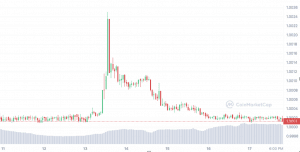What are stablecoins?
You can build a stablecoin by taking the value of a digital currency and tying it to the value of a stable asset like gold or fiat—e.g a gold-backed stablecoin trades at the value of gold per piece.
Tether Gold (xAUt) is the best example of a gold-backed stablecoin. It isn’t the only stablecoin to have been deployed by Tether, as we’ve seen the company create all manners of stablecoins.
One perk of owning Tether Gold is eliminating the burden of owning physical gold. You dont even have to pay custodial fees as you would do for actual gold.
There is also a fiat-backed stablecoin like USDT or BUSD. Both of these are tethered to the value of the US-Dollar on a ratio of 1:1.
Unlike the actual dollar, a fiat-backed stablecoin like USDT comes with convenience, speed, security, and privacy and eliminates third-party payment gateways.
The added advantage of cryptography means you are dealing with a decentralized crypto, free of middlemen; and one that comes with the stability of traditional currencies. Unlike Bitcoin or Ethereum.
How do stablecoins work?
Stablecoins are run with the help of a smart contract which manages the minting or creation process and validates their redemption.
The smart contracts are pre-programmed to make sure the redemption takes place at a 1:1 ratio. So that when a user deposits US- dollars, the dollars reside in the stablecoin issuers reserve. Therefore, ensuring that the digital asset’s users can redeem their fiat-backed tokens whenever they need to.
Here is the kicker, a stablecoin could have backing from a multitude of sources besides fiat, like the gold example mentioned above. However, the risk level of owning any type of stablecoin is directly proportional to the backing.
Therefore, this is why you are always likely to find two deviating stablecoins with a standard fiat- backing. For instance, USDT and BUSD are backed to the value of the USD at a 1:1 ratio yet they trade at different deviations.
Below we tracked down the price fluctuations of both BUSD and USDT for 7 days on CoinMarketCap.

Tether (USDT) Price changes over 7-days by Coin Market Cap

BUSD Price changes over 7-days by Coin Market Cap
What the above two little graphs are sayings is this, imagine you’re a sailor and you’ve got a big ol’ treasure chest full of gold doubloons. You don’t want those doubloons to lose their value, so you tie ’em up in a big bag and throw it overboard. But wait, what if the bag sinks or floats away with the tide? That’s where stablecoins come in.
Stablecoins are like magic bags that always stay put, no matter how rough the waters get. They’re tied to something called a “peg,” which is basically like an anchor that keeps the value of the stablecoin steady. So, when the value of other cryptocurrencies is bouncing around like a drunk pirate, stablecoins stay nice and steady, like a trusty ship that always finds its way back to port.
Read also: USDT, USDC, and BUSD – Which is the best?
Crypto-backed s Vs fiat-backed stablecoins
Crypto-backed stablecoins
Bitcoin-backed stablecoin.” These coins are a bit like a pirate’s treasure map – they promise riches beyond your wildest dreams, but there’s always the risk of a storm on the horizon.
See, these stablecoins are tied to the value of Bitcoin, which as we all know, can be as unpredictable as a drunken sailor on shore leave. One minute Bitcoin might be worth a fortune, and the next it might be worth less than a rusty hook.
So, just like a pirate navigating through treacherous waters, the issuers of Bitcoin-backed stablecoins have to be extra careful to make sure their coins stay anchored to the value of Bitcoin. But even the most skilled sailors can’t control the winds and tides, and sometimes Bitcoin’s value can be affected by all sorts of things – from news about government regulations to Elon Musk’s latest tweet.
And that’s where the real adventure begins, me hearties. Will the Bitcoin-backed stablecoin stay steady, or will it be tossed around like a ship in a storm? It’s a gamble, to be sure, but for those brave enough to take the risk, the rewards can be great. Just remember to keep a weather eye on the horizon, and always be ready to adjust course if things start to get rough!
A good captain does not abandon his ship midstream.
Examples of crypto-backed stablecoins include DAI and USDX.
Fiat-backed stablecoin
A fiat-backed stablecoin is a kid who gets a weekly allowance from their parents. They know exactly how much money they’ll get, and they can use that money to buy things in the real world. It’s kind of like Monopoly money, but with real value.
On the other hand, a crypto-backed stablecoin is like a kid who collects Pokemon cards. They don’t really know how much their cards are worth, but they have a hunch that they’re valuable. So they use those cards to buy things from other kids who also collect Pokemon cards. It’s like a trading game, but with fake creatures instead of money.
Now, imagine the parents of the kid with the allowance suddenly decide to stop giving them money. The kid is stuck with a bunch of worthless Pokemon cards, and they can’t buy anything in the real world. That’s kind of what happens with fiat-backed stablecoins if the underlying fiat currency loses value.
But if the kid with the Pokemon cards suddenly discovers that the cards they thought were valuable are actually fake knock-offs, they’re also in trouble.
They can’t buy anything from the other kids, and they’re stuck with a bunch of worthless paper. That’s what can happen with crypto-backed stablecoins. If cryptocurrency they’re backed by drops, they drop too.
So, to summarize: fiat-backed stablecoins are like Monopoly money, while crypto-backed stablecoins are like Pokemon cards. Both have their risks, but at least with Monopoly money, you can always count on it being worth something.
As for Pokemon cards, well, they’re only valuable if you can convince someone else to give you something in exchange for them. Good luck with that!
BUSD, USDT and USDC are good examples of fiat-backed stablecoins backed to the United States value at a 1:1 ratio. However, Tether(USDT) is backed by a mix of both fiat and Bitcoin. Circle also made an announcement to diversify its reserve and add some more asset classes for backing its stablecoin.
You might probably ask,
“Yoh! What’s the difference between these stablecoins? USDT backed to a mix of assets, BUSD backed to just the US-Dollar.
Let’s explore the differences between BUSD, USDT and USDC
What are the differences between BUSD, USDT and USDC
The main factor that causes differences between BUSD, USDT and USDC is the blockchains they run on. Each blockchain’s advantages add up to the pros of each coin. If transaction costs are low on Blockchain 1, this means the costs will remain low for the stablecoin running on top of it.
|
Variables |
BUSD |
USDT |
USDC |
|
Issuer |
|
|
|
|
Year of Launch |
2019 |
2014 |
2018 |
|
Multichain support |
|
|
|
|
Stability |
Stable |
Stable |
Stable |
|
Reserve Management |
|
|
|
|
Pros |
|
|
|
|
Auditing Company |
|
|
|
How Does BUSD Work?
Paxos and Binance created BUSD to support fast and flexible crypto transactions. BUSD is backed to the US dollar at a 1:1 ratio and is cash redeemable.
Both exchanges choose Ethereum and the BNB chain as the foundation chains for BUSD. Which, therefore, facilitated the inter-blockchain transfer and payment flexibility.
Already, the Binance Dollar has expanded its partnership to include OKX, Huobi, Trust Wallet and a few financial infrastructure platforms like BlockFI. Unfortunately, the stablecoin currently faces increasing regulatory and transparency issues. The auditing firm for BUSD is Withum, a top-ranking accounting company.
Read also: Are stablecoins securities?
How USDT works?
Imagine you have a friend named Ted who always owes you money, but never has cash on hand.
One day, Ted tells you that he’s going to give you something called “Ted’s Bucks,” which are pegged to the value of the U.S. dollar. For every Ted’s Buck, he gives you, he promises to keep a real dollar in a vault somewhere.
So, you accept Ted’s offer and start accepting Ted’s Bucks instead of real cash. You can use these Ted’s Bucks to buy things or lend them to other people, and they’ll always be worth one dollar.
However, there’s a catch – you can only redeem your Ted’s Bucks for real dollars if you go to Ted’s vault and ask him to give you your money back. And, you have to trust that Ted actually has enough real dollars in the vault to cover all the Ted’s Bucks he’s issued.
In the world of cryptocurrency, Ted is like Tether (the company behind USDT), and Ted’s Bucks are like USDT. Just like with Ted’s Bucks, you can use USDT for transactions and it’s supposed to be backed by real dollars in a reserve somewhere. But, you have to trust that Tether actually has the reserves it claims to have.
Tether has gone out of its way to maintain clear transparent reserve management. Regardless of which, people have surrounded the stablecoin issuer with various controversies around decentralization and stability.
How about USDC?
USDC aims to neutralize the volatility of cryptocurrencies by processing quick payment transfers. The stablecoin was created by Circle Internet Finance on the Ethereum blockchain. Unlike the USDT, USDC is fully collateralized.
Furthermore, Circle’s reserves are more transparent compared to USDT. Users redeem 1:1 of their USD through the platform’s regulated partners.
These partners have to undertake monthly audits to ensure reserves are sufficient. Therefore ensuring trust and transparency across the ecosystem of the stablecoin. USDC runs on several chains including Avalanche, Tron, Solana, Algorand, Polygon and Hedera.
Bottomline
Each stablecoin comes with its own pros and cons. The choice runs down to one’s personal preferences. For example, if I am more of a Buterin fan, certainly I will pick one that supports ERC-20 or most probably one that runs on an Ethereum ecosystem chain like Polygon.



